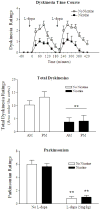Nicotine and Parkinson's disease: implications for therapy
- PMID: 18683238
- PMCID: PMC4430096
- DOI: 10.1002/mds.21900
Nicotine and Parkinson's disease: implications for therapy
Abstract
Accumulating evidence suggests that nicotine, a drug that stimulates nicotinic acetylcholine receptors, may be of therapeutic value in Parkinson's disease. Beneficial effects may be several-fold. One of these is a protective action against nigrostriatal damage. This possibility stems from the results of epidemiological studies that consistently demonstrate an inverse correlation between tobacco use and Parkinson's disease. This reduced incidence of Parkinson's disease has been attributed to the nicotine in tobacco products, at least in part, based on experimental work showing a protective effect of nicotine against toxic insults. Second, several studies suggest a symptomatic effect of nicotine in Parkinson's disease, although effects are small and somewhat variable. Third, recent data in nonhuman primates show that nicotine attenuates levodopa-induced dyskinesias, a debilitating side effect that develops in the majority of patients on levodopa therapy. Collectively, these observations suggest that nicotine or CNS selective nicotinic receptor ligands hold promise for Parkinson's disease therapy to reduce disease progression, improve symptoms, and/or decrease levodopa-induced dyskinesias.
(c) 2007 Movement Disorder Society.
Figures

Similar articles
-
Nicotine and Nicotinic Receptor Drugs: Potential for Parkinson's Disease and Drug-Induced Movement Disorders.Int Rev Neurobiol. 2015;124:247-71. doi: 10.1016/bs.irn.2015.07.005. Epub 2015 Aug 18. Int Rev Neurobiol. 2015. PMID: 26472532 Review.
-
Targeting nicotinic receptors for Parkinson's disease therapy.CNS Neurol Disord Drug Targets. 2011 Sep 1;10(6):651-8. doi: 10.2174/187152711797247849. CNS Neurol Disord Drug Targets. 2011. PMID: 21838678 Free PMC article. Review.
-
Alpha7 nicotinic receptors as therapeutic targets for Parkinson's disease.Biochem Pharmacol. 2015 Oct 15;97(4):399-407. doi: 10.1016/j.bcp.2015.06.014. Epub 2015 Jun 18. Biochem Pharmacol. 2015. PMID: 26093062 Free PMC article. Review.
-
Can nicotine be used medicinally in Parkinson's disease?Expert Rev Clin Pharmacol. 2011 Jul;4(4):429-36. doi: 10.1586/ecp.11.27. Expert Rev Clin Pharmacol. 2011. PMID: 22114853 Review.
-
Multiple roles for nicotine in Parkinson's disease.Biochem Pharmacol. 2009 Oct 1;78(7):677-85. doi: 10.1016/j.bcp.2009.05.003. Epub 2009 May 9. Biochem Pharmacol. 2009. PMID: 19433069 Free PMC article. Review.
Cited by
-
Nicotine induces morphological and functional changes in astrocytes via nicotinic receptor activity.Glia. 2021 Aug;69(8):2037-2053. doi: 10.1002/glia.24011. Epub 2021 Apr 14. Glia. 2021. PMID: 33851731 Free PMC article.
-
Allosterism of Nicotinic Acetylcholine Receptors: Therapeutic Potential for Neuroinflammation Underlying Brain Trauma and Degenerative Disorders.Int J Mol Sci. 2020 Jul 12;21(14):4918. doi: 10.3390/ijms21144918. Int J Mol Sci. 2020. PMID: 32664647 Free PMC article. Review.
-
Novel therapeutic strategies in Parkinson's disease.Eur J Clin Pharmacol. 2010 Feb;66(2):119-25. doi: 10.1007/s00228-009-0742-4. Epub 2009 Oct 16. Eur J Clin Pharmacol. 2010. PMID: 19834698 Review.
-
A case-control study of the protective effect of alcohol, coffee, and cigarette consumption on Parkinson disease risk: time-since-cessation modifies the effect of tobacco smoking.PLoS One. 2014 Apr 30;9(4):e95297. doi: 10.1371/journal.pone.0095297. eCollection 2014. PLoS One. 2014. PMID: 24788751 Free PMC article.
-
Nicotine as a potential neuroprotective agent for Parkinson's disease.Mov Disord. 2012 Jul;27(8):947-57. doi: 10.1002/mds.25028. Epub 2012 Jun 12. Mov Disord. 2012. PMID: 22693036 Free PMC article. Review.
References
-
- Samii A, Nutt JG, Ransom BR. Parkinson’s disease. Lancet. 2004;363:1783–1793. - PubMed
-
- Lang AE, Obeso JA. Challenges in Parkinson’s disease: restoration of the nigrostriatal dopamine system is not enough. Lancet Neurol. 2004;3:309–316. - PubMed
-
- Singh N, Pillay V, Choonara YE. Advances in the treatment of Parkinson’s disease. Prog Neurobiol. 2007;81:29–44. - PubMed
-
- Hodaie M, Neimat JS, Lozano AM. The dopaminergic nigrostriatal system and Parkinson’s disease: molecular events in development, disease, and cell death, and new therapeutic strategies. Neurosurgery. 2007;60:17–28. discussion 28-30. - PubMed
Publication types
MeSH terms
Substances
Grants and funding
LinkOut - more resources
Full Text Sources
Other Literature Sources
Medical

